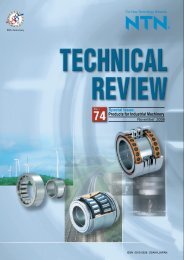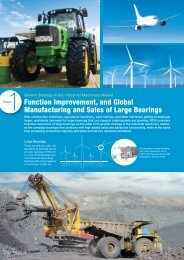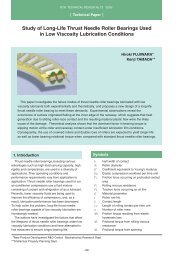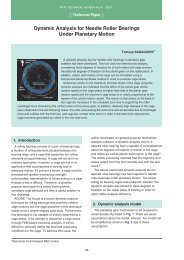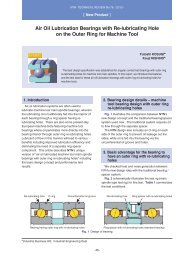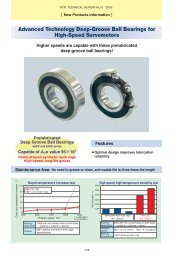High-speed Angular Contact Ball Bearings New 9 Series for ... - NTN
High-speed Angular Contact Ball Bearings New 9 Series for ... - NTN
High-speed Angular Contact Ball Bearings New 9 Series for ... - NTN
Create successful ePaper yourself
Turn your PDF publications into a flip-book with our unique Google optimized e-Paper software.
<strong>High</strong>-<strong>speed</strong> <strong>Angular</strong> <strong>Contact</strong> <strong>Ball</strong> <strong>Bearings</strong> <strong>New</strong> 9 <strong>Series</strong> <strong>for</strong> Machine Tool<br />
On the disadvantage side, having balls smaller than<br />
those of 0 series, 9 series bearings are inferior to 0<br />
series bearings in terms of their radial load capacity<br />
and maximum allowable axial load. To eliminate this<br />
problem, <strong>NTN</strong> has developed 9 series bearing variants<br />
that boast greater load capacity.<br />
3. Improved functions on <strong>New</strong> 9 <strong>Series</strong><br />
products<br />
3.1 Load rating and allowable axial load<br />
Our newly developed high-<strong>speed</strong> angular contact<br />
ball bearing products—new 9 series—feature improved<br />
internal design that include rolling elements of<br />
increased diameter as shown in Fig. 2, thereby the<br />
load rating has been improved by a maximum of 50%<br />
and the allowable axial load has been increased by<br />
<strong>New</strong> design<br />
Old design<br />
Fig. 2 Design of new product<br />
20% (Fig. 3). Consequently, the new 9 series bearing<br />
products boast longer life and increased allowance<br />
against axial load that occurs during tool change<br />
process on machine tools; thus, these bearings will be<br />
used in a larger scope of applications.<br />
Fig. 4 provides axial rigidity graph and radial rigidity<br />
graph with high-<strong>speed</strong> angular contact ball bearings<br />
(new design and old design), internal bore diameter<br />
100 mm, with constant pressure preload (GN preload).<br />
3.2 Result of operation test<br />
The result of operation test with the high-<strong>speed</strong><br />
angular contact ball bearings (new design and old<br />
design) is described below.<br />
Fig. 5 schematically illustrates the construction of<br />
the test rig (main spindle type test rig) used <strong>for</strong> the test.<br />
Fig. 6 summarizes a result of temperature rise test<br />
on the new and old bearing design variants with<br />
ceramic balls, air-oil lubricated, and with fixed position<br />
preload.<br />
The pattern of heat rise on the outer ring of our new<br />
design, up to dmn = 1.4510 6 (12,000 min -1 ) is<br />
identical to that of the old design. However, at higher<br />
<strong>speed</strong> range, the temperature with the new design is<br />
somewhat higher (1 to 2˚C). A possible cause is a<br />
larger ball size, which leads to greater PV value<br />
(contact surface pressure x slip velocity).<br />
140<br />
Basic dynamic load rating Basic static load rating Allowable axial load<br />
120<br />
100<br />
<strong>New</strong> design<br />
Old design<br />
kN<br />
80<br />
60<br />
40<br />
20<br />
0<br />
50<br />
100 150 50 100 150 50 100 150<br />
Fig. 3 Basic load ratings and allowable axial load (steel ball, contact angle 20˚)<br />
15<br />
6<br />
Axial displacement μm<br />
10<br />
5<br />
<strong>New</strong> design<br />
Old design<br />
Radial displacement μm<br />
5<br />
4<br />
3<br />
2<br />
1<br />
<strong>New</strong> design<br />
Old design<br />
0<br />
0 500 1000 1500 2000 2500 3000<br />
Axial load N<br />
0<br />
0 500 1000 1500 2000 2500 3000<br />
Radial load N<br />
Fig. 4 Rigidity graph (bearing bore dia. 100 mm, constant pressure preload)<br />
-51-


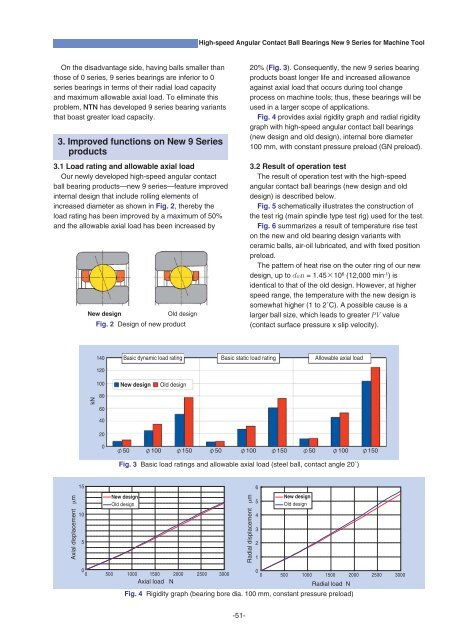
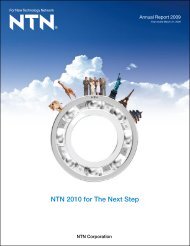
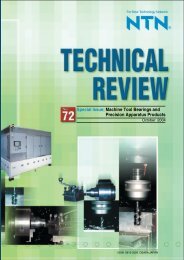
![[New Product] Unit Products for Office Equipment - NTN](https://img.yumpu.com/27154451/1/184x260/new-product-unit-products-for-office-equipment-ntn.jpg?quality=85)
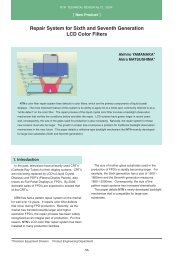
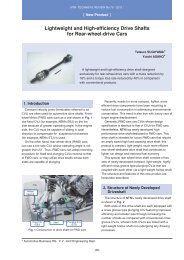
![[New Product] Development of Oil-impregnated Sintered ... - NTN](https://img.yumpu.com/27154427/1/184x260/new-product-development-of-oil-impregnated-sintered-ntn.jpg?quality=85)
